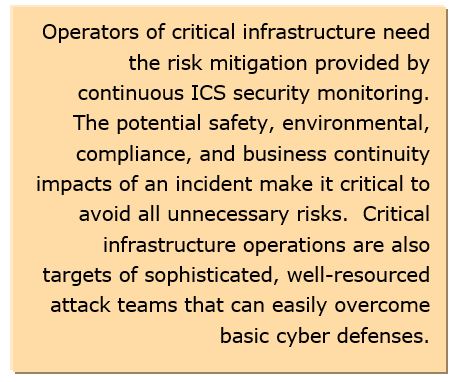


Continuous industrial control system (ICS) security monitoring technologies provide defenders with the visibility needed. While some companies may not be aware of these solutions, others are already integrating them into their cybersecurity management programs. Chief information officers (CIOs), chief information and security officers (CISOs), and active defenders in corporate security operations centers (SOCs) are also interested in the real-time plant security visibility these solutions provide. Suppliers support these needs and are working to extend integration with popular cyber-defense tools.
ARC discussed these issues with Nozomi Networks executives during a recent briefing. As we learned, critical infrastructure operators around the world use the company’s SCADAguardian platform to monitor their ICS cybersecurity in real time and detect threats.
ARC’s Industrial Cybersecurity Maturity Model illustrates the importance of continuous ICS security monitoring. We developed this model to help industrial managers understand cybersecurity challenges without having to become cybersecurity experts. It also provides a way for managers to understand cybersecurity investments with respect to cyber risks and the cost-benefits of different technologies.

ARC’s model breaks cybersecurity into a set of steps that reduce cyber risks incrementally. Each step addresses a specific, easily understandable, security issue. These include securing individual devices, defending plants from external attacks, containing malware that may still get into a control system, monitoring systems for suspicious activity, and actively managing sophisticated threats and cyber incidents. Each step has an associated set of actions, technologies, and resources that can be used to accomplish its goals. Continuous ICS security monitoring is the foundation for level four cyber risk mitigation.
Government and industry ICS cybersecurity guidelines and standards generally focus on getting companies to invest in at least a minimum level of protection against common cyber-attack scenarios. This roughly equates to the first three steps in ARC’s model and may be adequate for companies in low-risk industries and regions or those that can tolerate some process disruptions.
Operators of critical infrastructure don’t have this luxury. They need the additional risk mitigation provided by the higher steps in ARC’s model. The potential safety, environmental, compliance, and business continuity impact of an incident in these operations demands that all unnecessary risks be avoided. Recent incidents, particularly in power networks, show that critical infrastructure operations are also targets of sophisticated, well-resourced attack teams that can easily overcome basic cyber defenses.
IT cybersecurity teams have many tools for monitoring the security of business systems. But continuous ICS security monitoring has unique challenges and constraints that typically demand a built-for-purpose solution. Following are ARC’s requirements for an acceptable ICS solution:
The Nozomi Networks solution fulfills all the above requirements for continuous ICS security monitoring. The solution includes two key components: SCADAguardian, which continuously gathers and analyzes real-time messages flowing in control system networks; and, a central management console that aggregates data from multiple sites to provide centralized and remote cybersecurity management.

The SCADAguardian product has built-in DPI support for a wide range of popular IT and industrial protocols and the company has a protocol SDK to address other parsing needs. SCADAguardian uses sophisticated machine learning analysis methods to help ensure rapid, reliable detection of suspicious activity. This includes artificial intelligence, rules, and signature-based detection of abnormal behavior patterns and process anomalies.
SCADAguardian supports auto discovery with highly visual mapping of industrial assets. This includes identifying devices and vulnerabilities. Results are presented in the system dashboard in a user friendly way that facilitates visibility and enables users to drill down on all asset and vulnerability information. The SCADAguardian dashboards, reports, and alerts are also customizable.
According to the company, the Nozomi Networks central management console scales to monitor thousands of sites and supports various deployment options and hierarchical aggregation of ICS data. The product can also be used as a multitenancy solution for shared or MSSP (Managed Security Service Provider) deployments and very large-scale enterprise deployments.
Integration has been a key focus of Nozomi Networks development efforts. The company has developed interfaces for a wide range of ICS products, networking devices, SIEMs, and popular security management products, like FireEye and Leidos ASM. The company also has an open API for sharing data with external applications. Integrations with industrial firewalls enable asset operators to automatically block attacks.
Operators of critical infrastructure need to do all they can to minimize the safety, environmental, compliance, and business continuity risks related to cyber-attacks. This includes rapidly detecting and remediating system anomalies to minimize the impact of a successful intrusion.
Continuous ICS security monitoring provides the visibility that defenders need to manage today’s sophisticated attacks. Our review of Nozomi Networks illustrates that good solutions are available and ARC encourages operators to consider how this technology might improve their cybersecurity program and provide related operational benefits.
If you would like to buy this report or obtain information about how to become a client, please Contact Us
Keywords: Anomaly and Breach Detection, Continuous ICS Security Monitoring, Nozomi Networks, ARC Advisory Group.

